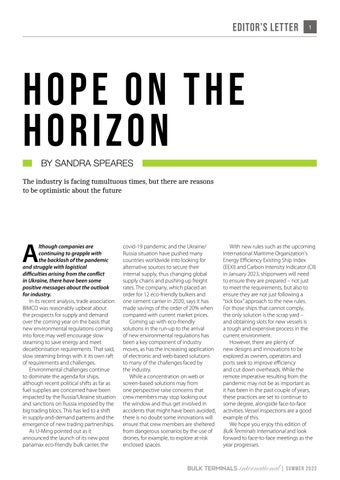EDITOR’S LeTTER
1
HOPE ON THE HORIZON BY SANDRA SPEARES The industry is facing tumultuous times, but there are reasons to be optimistic about the future
A
lthough companies are continuing to grapple with the backlash of the pandemic and struggle with logistical difficulties arising from the conflict in Ukraine, there have been some positive messages about the outlook for industry. In its recent analysis, trade association BIMCO was reasonably upbeat about the prospects for supply and demand over the coming year on the basis that new environmental regulations coming into force may well encourage slow steaming to save energy and meet decarbonisation requirements. That said, slow steaming brings with it its own raft of requirements and challenges. Environmental challenges continue to dominate the agenda for ships, although recent political shifts as far as fuel supplies are concerned have been impacted by the Russia/Ukraine situation and sanctions on Russia imposed by the big trading blocs. This has led to a shift in supply-and-demand patterns and the emergence of new trading partnerships. As U-Ming pointed out as it announced the launch of its new post panamax eco-friendly bulk carrier, the
covid-19 pandemic and the Ukraine/ Russia situation have pushed many countries worldwide into looking for alternative sources to secure their internal supply, thus changing global supply chains and pushing up freight rates. The company, which placed an order for 12 eco-friendly bulkers and one cement carrier in 2020, says it has made savings of the order of 20% when compared with current market prices. Coming up with eco-friendly solutions in the run-up to the arrival of new environmental regulations has been a key component of industry moves, as has the increasing application of electronic and web-based solutions to many of the challenges faced by the industry. While a concentration on web or screen-based solutions may from one perspective raise concerns that crew members may stop looking out the window and thus get involved in accidents that might have been avoided, there is no doubt some innovations will ensure that crew members are sheltered from dangerous scenarios by the use of drones, for example, to explore at-risk enclosed spaces.
With new rules such as the upcoming International Maritime Organization's Energy Efficiency Existing Ship Index (EEXI) and Carbon Intensity Indicator (CII) in January 2023, shiponwers will need to ensure they are prepared – not just to meet the requirements, but also to ensure they are not just following a “tick box” approach to the new rules. For those ships that cannot comply, the only solution is the scrap yard – and obtaining slots for new vessels is a tough and expensive process in the current environment. However, there are plenty of new designs and innovations to be explored as owners, operators and ports seek to improve efficiency and cut down overheads. While the remote imperative resulting from the pandemic may not be as important as it has been in the past couple of years, these practices are set to continue to some degree, alongside face-to-face activities. Vessel inspections are a good example of this. We hope you enjoy this edition of Bulk Terminals International and look forward to face-to-face meetings as the year progresses.
BULK TERMINALS
international | SUMMER 2022













